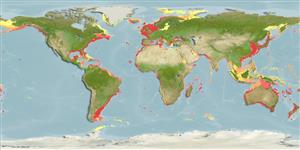Common names from other countries
Environment: milieu / climate zone / depth range / distribution range
Ecologia
Pelágico(a,os,as); estuarina; intervalo de profundidade 0 - 200 m (Ref. 1134). Tropical; 3°C - 30°C (Ref. 1134)
Circumglobal except Antarctic.
Length at first maturity / Tamanho / Peso / Idade
Maturity: Lm ? range ? - ? cm Max length : 0.2 cm TL macho/indeterminado; (Ref. 1610)
Marine, planktonic; found at depths up to 200 m, with waters temperatures of 3.2 to 29.5°C; rare in the open sea (Ref. 1134). Prefers neritic ambience (Ref. 3531). Found in mangrove vegetate area (Ref. 121475).
Life cycle and mating behavior
Maturidade | Reprodução | Desova | Ovos | Fecundidade | Larvas
Members of the class Appendicularia are protandrous hermaphrodites. Life cycle: Eggs develop into hatchlings (feeding juveniles) before turning into adults.
Hopcroft, R.R., J.C. Roff and H.A. Bouman. 1998. (Ref. 378)
Categoria na Lista Vermelha da IUCN (Ref. 130435)
Categoria CITES (Ref. 108899)
Not Evaluated
Not Evaluated
Utilização humana
| FishSource |
Ferramentas
Mais informação
Idade/TamanhoCrescimentoComprimento-pesoComprimento-comprimentoMorfologiaLarvasAbundância
Fontes da internet
Estimates based on models
Preferred temperature
(Ref.
115969): 6.5 - 25.9, mean 13.6 (based on 2008 cells).
Vulnerabilidade
Low vulnerability (10 of 100).
Categoria de preço
Unknown.
